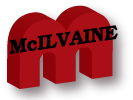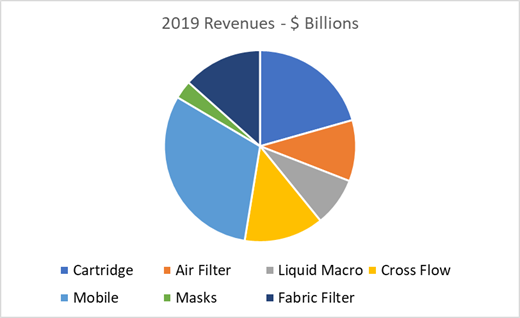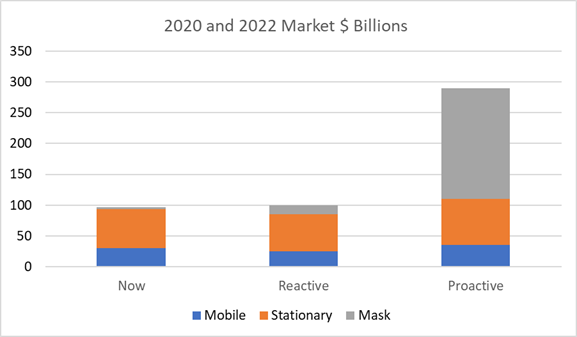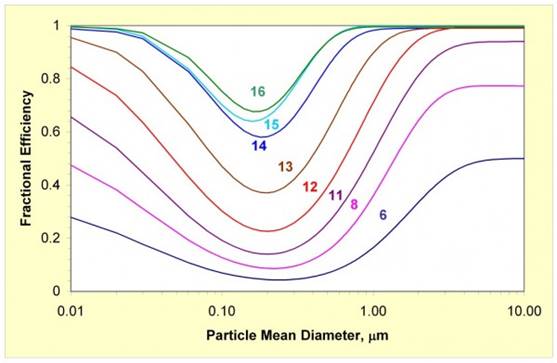
Coronavirus Technology Solutions
July 8, 2020
Filtration Revenues Could Triple
by 2022
M+H Cabin Filters Provide COVID
Protection
qlair Identifies, the Air Flow
Problem and Provides Solutions
to Optimize the Hospital
Ventilation.
New York State Government
Employees want HEPA Filters in
Their Buildings
Lack of Air Flow Knowledge has
Slowed Acceptance of the
Importance of Efficient Masks
______________________________________________________________________________
Filtration Revenues Could Triple
by 2022
The filtration industry can be
proactive and provide solutions
to mitigate
COVID or it can be
reactive and face the possible
consequences of reduced economic
activity for years to come.
The present market is $97
billion and is segmented into
seven product areas.

The cartridge filter market is
$20 billion.
Twenty-five percent is
pharmaceutical and health care
which will not be negatively
impacted by COVID. Fifty percent
is in metals, electronics,
power, oil and gas and other
industries where COVID is
lowering activity. Twenty-five
percent is in commercial and
residential use which could be
negatively impacted by
acceleration of the pandemic.
Air filtration is a $10 billion
market with most areas
negatively impacted by COVID.
The pharmaceutical and
healthcare sectors are the
exceptions.
A proactive approach will
substantially increase revenues
in commercial and residential
air filtration.
Fabric filters (air pollution
control) represent a $13 billion
market which is mostly adversely
impacted by COVID. The major
purchasers include steel,
mining, power, and cement
companies.
Liquid filtration is an $8
billion market and includes
large filter presses and belt
filters used in mining,
chemicals, and wastewater.
Most of the applications
are negatively impacted by
reduced economic activity.
Crossflow membranes (RO, UF, MF)
is a $13 billion market with one
third of the market in
desalination. Pharmaceutical and
health care are growing
segments.
The mobile filter market is a
$30 billion market which is
negatively impacted by loss in
new automobile production.
Upgrading of cabin air
filters to deal with COVID is a
minor offsetting factor.
Masks and respirators:
the market for masks was
less than than $3 billion at the
start of 2020.
Assuming that N80 masks
are required in the future and
assuming there is a washable
version reducing mask cost to
$0.25 per person per day and
that 2 billion people are using
these masks, the daily mask
revenue will be $500 million and
annual revenue would be $182
billion
With a reactive filtration
industry 2022 revenues could be
slightly higher based on
increased mask sales offsetting
shrinkage in other
segments.

With a proactive filtration
industry revenues could triple
by 2022. Most of the
major filter companies including
those who have never been
involved with masks are now
involved. New media materials
can assure increased comfort and
efficiency at affordable cost.
Use of directional air flow and
high efficiency filters can
result in efficient COVID
mitigation in commercial,
residential, and industrial
facilities.
The filtration industry needs to
be proactive. It has taken six
months for WHO to even concede
that small COVID aerosols are a
major transmission source.
Partitions are being mandated
without regard to related air
turbulence. Governments,
suppliers, and the public all
need access to the latest
insights and developments.
McIlvaine is providing a
program entitled Coronavirus
Technology Solutions
with this goal in
mind.
Click here for more information.
For more information on
McIlvaine Market Reports in each
filtration area click on markets
at www.mcilvanecompany.com
Bob McIlvaine can answer your
questions.
You can reach him at 847
226 2391 or
rmcilvaine@mcilvainecompany.com
M+H Cabin Filters Provide COVID
Protection
Mann+Hummel has created unique cabin filters with high particulate efficiency and incorporate gas phase removal and antimicrobial coatings. The potential to monitor air quality and control air flow through the filter adds flexibility to decrease energy consumption or conversely to maximize filtration volume.
It would seem that this
capability can be utilized to
optimize COVID mitigation.
Common cabin filters include a
particulate filter and
frequently also an activated
carbon layer. This is also true
for the cabin filters from
MANN+HUMMEL. The particulate
filter layer almost completely
separates coarse particles such
as dust, pollen and tire debris
as well as the smallest,
respirable particles such as
particulate matter. The layer of
activated carbon adsorbs harmful
gases, unpleasant odors and
ozone almost completely from the
air flowing through the system.
But these cabin filters also have a third layer with a special biofunctional coating made from so-called polyphenols. Polyphenols are natural products with an anti-inflammatory effect and are perceived to promote good health. They are present in plants such as green tea and pomegranates and many others and have the ability to adsorb allergens and make them harmless. This mechanism is exploited by MANN+HUMMEL.
The polyphenol coating has an
antiallergenic and antimicrobial
effect. It
protects the driver and vehicle
occupants against bacteria, mold
fungi and allergens and adsorbs
them by up to 100 percent.
Growth of mold fungi will
decrease by more than 95
percent. This allows us to nip
diseases in the bud, and those
suffering from allergies can
breathe freely.
M+H use different types of
activated carbon to filter out
gaseous contaminants. The carbon
surface is characterized by
a very fine pore structure which
binds gas molecules. Expertise
is based on the ability to
combine different activated
carbons in a single filter
medium. That allows M+H to
exactly fine-tune filters and
reliably retain the various
pollutants. This is particularly
true in the case of nitrogen
dioxide. Here activated carbon
media provide highly effective
protection which is validated in
field tests and with independent
laboratories.
The trend here is towards ever
finer filtration. In recent
years, the demand for high
efficiency particulate air
filters (HEPA filters) has
risen. These products allow the
retention of more than 99.95
percent of all particles. These
filters usually find application
in clean rooms. In areas with
road traffic, they would clog
within a short period of time.
Therefore, M+H
combines them with
a pre-filter to a filter system
and fine-tune these to work
together.
One major challenge for electric
vehicles is to maximize their
driving range. Therefore, the
energy of the battery should be
dedicated for driving and not be
used for climate control in the
interior of the vehicle.
The intelligent system
FreciousSmart allows the air to
circulate inside the cabin after
it has been heated up once.
However, at some point the air
does become sticky and damp, and
a certain amount of air from the
outside is required. The indoor
air quality sensor in the system
measures the CO2 content,
the air humidity and temperature
and determines how much outdoor
air is actually required. At the
same time, another sensor
measures the quality of the
outside air and only switches on
the respectively required
filter. This offers constantly
maximum protection for the
occupants of the vehicle while
maximizing the driving range and
enabling the longest change
interval for the filter.
qlair Identifies, the Air Flow
Problem and Provides Solutions
to Optimize the Hospital
Ventilation.
Proper indoor air quality
management can save
hospitals thousands in
energy every year, while making
the indoor environment healthier
and increasing employee
performance. Savings for
hospitals can be immense, as the
2003 CBEC Survey identified that
hospitals spend 10 times more on
energy than other building
types, which can equate to $8.8
billion in energy costs per
year. Optimizing the
HVAC system and properly
monitoring
indoor air quality can
ensure use of the correct filter
with the correct scheduling. In
addition, knowing when and where
the problem areas are can allow
the facility to make advanced
decisions on ventilation
efforts.
Now with COVID the harm from
poor ventilation is greatly
increased. The following success
story from Mann +Hummel qlair
occurred prior to COVID
but shows the process needed to
minimize COVID as well as VOCs.
Hospitals, being some of the
most at-risk facilities for poor
indoor air quality, can have
heavy exposure to harmful
chemicals and airborne bacteria
that cause illness and
discomfort. These issues can be
solved by proper ventilation and
data tracking. In fact, a study
done by ASHRAE found indoor air
quality that was improved by
appropriate ventilation reduced
acute respiratory illnesses by
up to 76 percent.
This can be attributed to data
collected from the same
research, concluding that there
was a higher concentration of
carbon dioxide and VOCs inside
urban hospitals than outdoors.
Running the HVAC system properly
and monitoring
indoor air quality can
allow the facility
to attack these problems
at the source in the most
cost-efficient manner.
Recently, qlair worked with a
hospital that was in need of
indoor air quality and
monitoring, due to employee
complaints of odor and poor
ventilation. The pathology lab
team had noticed an unpleasant
chemical smell, and there were
even tenants from other floors
complaining of the strong odor.
They needed better insight into
the situation and contacted the
team at qlair to help.
First, experts conducted a
walk-through of the facility to
identify potential sources of
the pollutant at work. They look
in every area, including storage
closets, different sections of
the lab, and other parts of the
facility to make sure everything
follows proper indoor air
quality protocol. During this
audit, we found the first
potential at-risk area, the
storage room containing various
chemicals.
Based the
assessment, it was clear
that the room was not properly
ventilated, and chemical
containers had been left open or
their lids were not tightly
shut. This was immediately taken
note of and was the first
suspect for which the pollution
was possible.
With a lead on the potential
problem area, qlair began its
installation process. Three
sensors were installed – one in
the chemical storage room,
another in the lab area, and the
third in the office area of the
facility. It was time to wait
and allow for the backend
solution to gather data from the
sensors, comparing different VOC
levels to the different areas of
the facility. After a few weeks
of letting the data do the work,
qlair was able to generate a
graph comparing the various
pollutant concentrations. The
results were most telling.

From the data collected, qlair
confirmed that the problem
resided within the storage
closet. Data showed
significantly higher levels of
VOC concentration in the storage
closet when compared to all
other areas, during all times of
the day. Other areas that were
at problem levels were also
identified during this time,
although none matched the
significance of the storage
room.
Given this data, qlair was able
to provide an actionable
solution to the client, which
not only completely eliminated
the issue in the storage room,
but also returned all areas of
the lab to the correct levels of
VOC concentration.
Most digital solutions can only
set up sensors and gather data,
which can let you know when
pollutants are at unsafe levels
but do not provide actionable
insights.
qlair identifies, the problem
and provides solutions to
optimize the building.
New York State Government
Employees want HEPA Filters in
Their Buildings
One of the state's largest
public labor unions is calling
on Gov. Andrew M. Cuomo to
require buildings that house
state workers to meet the same
air-filtration standards that
the governor recently said he
will impose on large malls and
potentially other private-sector
businesses.
The Public Employees Federation
(PEF) this week called on the
Governor's Office of Employee
Relations to mandate the
installation of high-efficiency
particulate air (HEPA) filters
to protect employees returning
to offices as New York reemerges
from a months-long “pause” on
business operations to slow the
spread of COVID-19.
If New York state is mandating
or recommending these filters
for large public spaces,
businesses and offices, then New
York state should follow its own
recommendations and ensure
adequate air filtration for its
own workers,” PEF President
Wayne Spence said in a news
release. “You must lead by
example, and this is an
opportunity for the governor to
do that.”
Cuomo last week said large malls
would be required to install
HEPA filters before they could
reopen.
Jason Conwall, a Cuomo
spokesman, said filters are
already installed in buildings
owned and managed by the Office
of General Services, which
functions as the state's
property manager.
Every precaution is being taken
to provide state workers with
the safe environment they
deserve, and buildings owned and
managed by the Office of General
Services are already using
MERV-13 rated filters, have
increased the mix of fresh air,
and are running HVAC fans before
and after work hours — all in
accordance with (Centers for
Disease Control) and (American
Society of Heating,
Refrigerating and
Air-Conditioning Engineers)
guidance," he said in an emailed
statement. "The state is also
working with our partners to
provide the same in leased
office spaces."
The MERV efficiency is far below
the most efficient HEPA filters
which would be MERV 20 .
the chart below shows the
relative efficiency of MERV 13
on particles 0.1 microns in
diameter would be around
50%.

Lack of Air Flow Knowledge has
Slowed Acceptance of the
Importance of Efficient Masks
Researchers from China and
Australia published a paper
linked below which
provides an explanation
as to why officials are slow to
understand the importance of
efficient masks.
They say that it is difficult to
explain why public health
authorities marginalize the
significance of airborne
transmission of influenza or
coronaviruses, but a possible
reason is that it is difficult
to directly detect the viruses
traveling in the air.
Immediately after expiration,
the plume carrying the expired
viral content is diluted, and as
it travels in the air carried by
the air flow. In the process,
the concentration of the virus
does not increase uniformly in
the interior environment of the
enclosed space, but it is
elevated only in the flow (if
there is adequate ventilation,
which is normally the case in
medical facilities or on
aircraft) (Morawska
2006).
Therefore, sampling for the
presence of the virus requires
knowledge of the air flow from
the infected person, and a
sufficiently long sampling
period to collect enough copies
of the viruses. Both these
requirements present major
challenges: microbiologists
collecting viral samples are not
normally experts in building
flow dynamics, and practicality
prevents long sampling times
that would be adequate for the
sensitivity of existing viral
detection methods (Booth
et al. 2005).
The fact that there are no
simple methods for detecting the
virus in the air does not mean
that the viruses do not travel
in the air. The above-mentioned
retrospective modeling studies
explained the transmission of
SARS-CoV-1 in 2003 (Booth
et al., 2005, Li
et al., 2005, Olsen
et al., 2003, Xiao
et al., 2017;12., Yu
et al., 2005).
While we do not yet have all the
required data in hand, including
for example data on the patterns
of infections, or specific
indoor characteristics where the
infections occurred, analysis of
the initial pattern of COVID-19
spread in China reveals multiple
cases of non-contact
transmission, especially in
areas outside Wuhan, such as
those in Hunan and Tianjin. On
numerous cruise ships where
thousands of people onboard were
infected, many of the infections
occurred after the imposition of
isolation that confined
passengers for the majority of
time to their cabins, and
limited direct contact, and with
hand hygiene carefully obeyed.
Was it therefore the ventilation
system that spread the airborne
virus between the cabins one of
the reasons for the infections?
There are also hypothesis, that
airborne transmission was at
least partially responsible for
a larger number of infections
during a choir, where 45 out of
60 choir members were infected (Read
2020).
Despite the evidence and strong
hypotheses, the world appears to
be locked in
the old way of thinking that
only direct contact matters in
viral infection spread. It is
disconcerting that with all the
experience and evidence
currently available, when faced
with a new viral outbreak of
COVID-19, the authorities still
fail to acknowledge the airborne
pathway of transmission,
although many experts in China
and other countries have had
experience in dealing with SARS.
We
predict that this failure to
immediately recognize and
acknowledge the importance of
airborne transmission and to
take adequate actions against it
will result in additional cases
of infection in the coming weeks
and months, which would not
occur if these actions were
taken. The air transmission
issue should be taken seriously
now, during the course of the
epidemic. When the epidemic is
over and retrospective data
demonstrates the importance of
airborne transmission it will be
too late. Further, the lessons
learnt now will prepare us
better for when the next
epidemic strikes.
To
summarize, based on the trend in
the increase of infections, and
understanding the basic science
of viral infection spread, we
strongly believe that the virus
is likely to be spreading
through the air. If this is the
case, it will take at least
several months for this to be
confirmed by science. This is
valuable time lost that could be
used to properly control the
epidemic by the measures
outlined above and prevent more
infections and loss of life.
Therefore, we plead that the
international and national
authorities acknowledge the
reality that the virus spreads
through air, and recommend that
adequate control measures, as
discussed above be implemented
to prevent further spread of the
SARS-CoV-2 virus.
